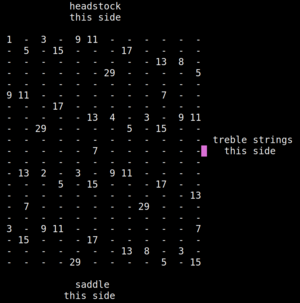Skip fretting system 58 2 17: Difference between revisions
Jump to navigation
Jump to search
m Categories |
Added links to dead end page |
||
| Line 1: | Line 1: | ||
This layout allows someone to play in 58-edo on a 29-edo guitar, by tuning the guitar in neutral thirds -- that is, with 17\58 between each pair of adjacent strings. | This layout allows someone to play in [[58-edo]] on a [[29-edo]] guitar, by tuning the guitar in neutral thirds -- that is, with 17\58 between each pair of adjacent strings. | ||
[[File:58-edo 117x2.png|thumb|Where every harmonic in the 17-limit + 29 group lie on a 17\58 x 2\58 isomorphic layout]] | [[File:58-edo 117x2.png|thumb|Where every harmonic in the 17-limit + 29 group lie on a 17\58 x 2\58 isomorphic layout]] | ||
The diagram, which could be interpreted as part of the fretboard of a 12-string guitar, shows where each of the 17-limit harmonics lies, plus the 29th harmonic. Since 58-edo is consistent in the 17-limit + 29, these harmonics' positions imply where every interval in that group lies. (For instance, to play 7/6 you move up one string and down one fret, because that takes you from harmonic 3 to harmonic 7.) Octaves are indicated as powers of 2 (specifically 1, 2, 4 and 8). | The diagram, which could be interpreted as part of the fretboard of a 12-string guitar, shows where each of the [[17-limit]] harmonics lies, plus the [[29/16|29th harmonic]]. Since 58-edo is [[consistent]] in the 17-limit + 29, these harmonics' positions imply where every interval in that group lies. (For instance, to play [[7/6]] you move up one string and down one fret, because that takes you from harmonic 3 to harmonic 7.) Octaves are indicated as powers of 2 (specifically 1, 2, 4 and 8). | ||
[[Category:58edo]] | [[Category:58edo]] | ||
[[Category:29edo]] | [[Category:29edo]] | ||
Revision as of 03:49, 9 January 2024
This layout allows someone to play in 58-edo on a 29-edo guitar, by tuning the guitar in neutral thirds -- that is, with 17\58 between each pair of adjacent strings.

The diagram, which could be interpreted as part of the fretboard of a 12-string guitar, shows where each of the 17-limit harmonics lies, plus the 29th harmonic. Since 58-edo is consistent in the 17-limit + 29, these harmonics' positions imply where every interval in that group lies. (For instance, to play 7/6 you move up one string and down one fret, because that takes you from harmonic 3 to harmonic 7.) Octaves are indicated as powers of 2 (specifically 1, 2, 4 and 8).